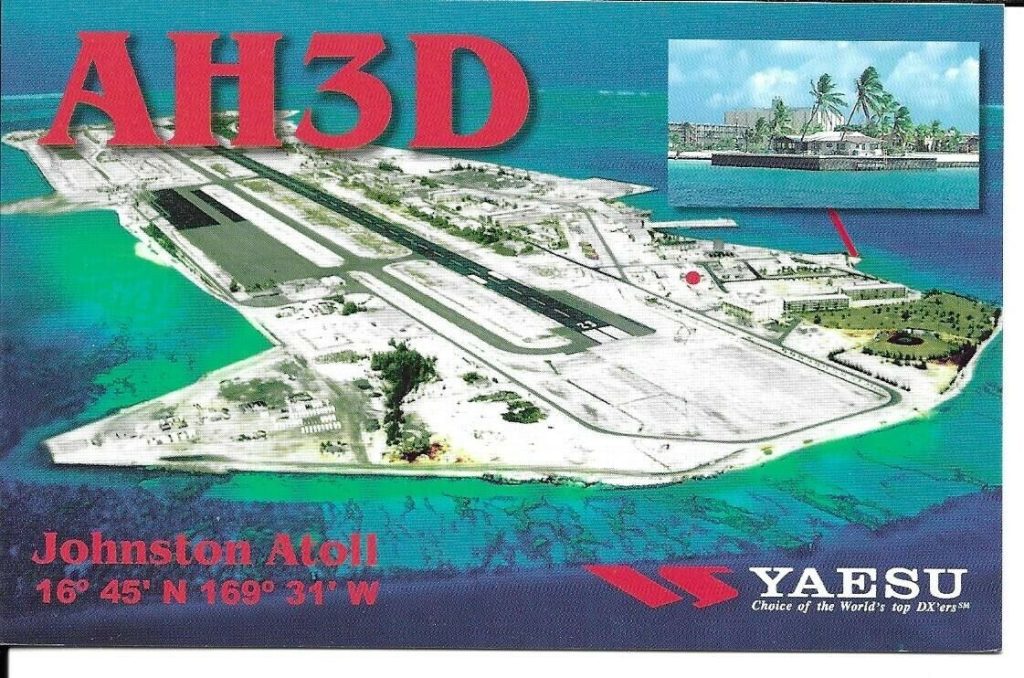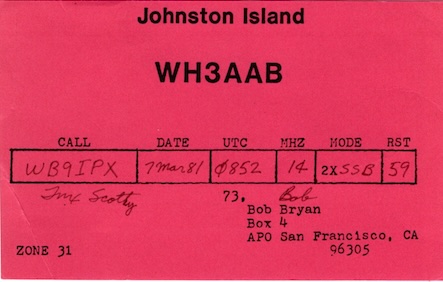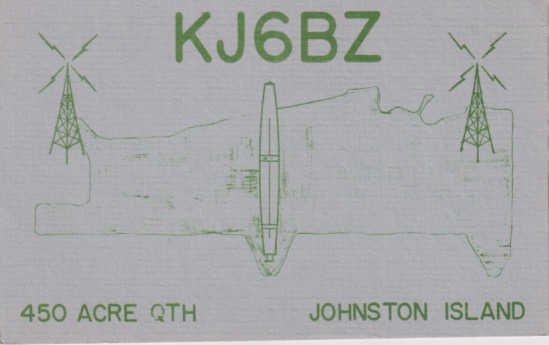In our overview of the rarest of the rare DXCC entities, today we’ll be looking at number six on the Most Wanted List per Clublog: Johnston Island.
OnAllBands asked the team at DX Engineering to scour their QSL card collections for contacts made with this seldomly activated location—and they delivered. With years of DXing conquests under their belts, we can always rely on them for cards that reach the most remote, infrequently visited corners of the globe. (A good reason to contact them when you want to upgrade your DXing capabilities.)
Before we tackle Johnston Island, check out these articles on the current top-five most-wanted entities:
Johnston Island/Atoll (KH3)
This unincorporated territory of the United States in the North Pacific Ocean (between the Marshall Islands and the Hawaiian Islands) is under the jurisdiction of the U.S. Air Force (USAF) and closed to public entry. The U.S. military has controlled Johnston Island since 1934, though it was decommissioned as a military installation in 2004. During this time, the island served as a naval refueling depot, airbase, missile base, and site for chemical weapons disposal and nuclear/biological testing. Johnston Atoll is made up of two natural islands (Johnston and Sand) and two human-made islands. The atoll’s total land area is about 1.03 square miles.
The atoll is part of the Pacific Islands Heritage Marine National Monument, which encompasses nearly 500,000 square miles of ocean, coral reef, and island habitats. A special permit from the United States Fish and Wildlife Service (USFWS)—in addition to authorization from the USAF—is required to access the land masses or the surrounding waters of Johnston Atoll, making it one of the toughest of all entities to put on the air. The Johnston Atoll Wildlife Refuge, established in 1926, extends from Johnston Island’s shore out 12 nautical miles. The Pacific Islands Heritage Marine National Monument extends out from its shore 200 nautical miles.
Both the USAF and USFWS monitor and help maintain the island’s extensive population of nesting seabirds, which includes more than 10,000 nests of red-tailed tropicbirds—the largest colony of this species in the world. An infestation of Yellow Crazy Ants which were killing off the atoll’s seabirds (yes, that’s what they’re actually called) was eradicated by the USFWS in 2021. The atoll is also considered a habitat for the endangered Hawaiian monk seal among its other biodiverse wildlife.
Johnston Island has no permanent population. While permission is granted to visit there for scientific research, education, or management needs, going ashore for ham radio operation has been excluded over the last couple of decades.
Attempts to receive permission to operate there have progressed but been denied. Read these insightful comments by Lou, N2TU, team leader of Wake Island K9W 2013, explaining the barriers faced by those hoping to activate heavily restricted Johnston Island. One military official cited fears that DXpeditioners would bring back hazardous materials from the island, which has a long history of contamination dating back to the Cold War (e.g., nuclear testing, storage of Agent Orange). The USAF completed a contamination remediation project on the island in 2004.
In March 2025, the Department of the Air Force announced plans to build two landing pads on Johnston Island designed to test cargo delivery via reusable rocket ships. Scientists and environmentalists have expressed concerns regarding possible contamination, debris, noise pollution, failed landings, and other potential negative impacts on the island’s avian population, including its effect on red-tailed tropicbirds.
Johnston Island DXpeditions
For an insider’s look at what it’s like operating from Johnston Island, read this article by Martti Laine, OH2BH, from the Autumn/Winter 2003 Northern California DX Foundation Newsletter (page 8), about the January/February 2003 AH3D activation which logged around 28,000 QSOs—the last significant number of QSOs recorded from the entity.

The March to July 2003 KH3/KT6E DXpedition was the last official time Johnston Island was on the air. John, KT6E, who was working on the island, was active when his schedule allowed it.
DXE QSL Cards
Scotty, KG9Z, DX Engineering customer/technical support specialist, provided us with this QSL card from the Bob Bryan, WH3AAB, activation of Johnston Island from October 1980 to May 1981.

Wayne, K8FF, DX Engineering customer/technical support specialist, received the QSL card below for making an SSB QSO with KJ6BZ, the Johnston Island Military Radio Club, in 1965 (his call sign was K8WOT at the time).

Stay tuned for Part 4 of our Top Ten series, featuring QSL cards from Peter 1 Island.
Visit DXEngineering.com for everything you need to upgrade your station to reach the rarest of the rare, including transceivers, amplifiers, antennas, towers, microphones, headsets, CW keys and paddles, and more.
***
Editor’s Note: Every month, DX Engineering features QSL cards from our team members’ personal collections. To highlight upcoming DXpeditions, we’ll be displaying a few of our favorite cards along with details about what it took to make these contacts. We’re excited to share some of the special cards pulled from the thousands we’ve received over the years. We look forward to seeing your cards as well!

